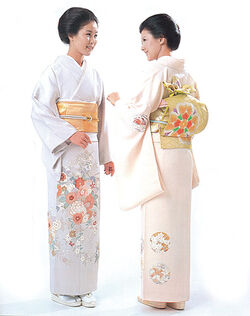
Two ladies in houmongi (left) and tsukesage (right).
Houmongi and Tsukesage are two styles of semi-formal kimono, with many similarities between them. This has lead to a great deal of confusion between the styles, and 'Houmongi-Tsukesage' hybrids have blurred the line even further. Both Houmongi and Tsukesage are most often characterized by patterns that wrap around the lower hem of the kimono, and are displayed on the sleeves and shoulders, typically on the back of the right sleeve and shoulder, and the front of the left sleeve and shoulder. While these are common examples, they can also display designs that cover the entire kimono, but are more heavily distributed to the afforementioned locations.
Some vintage Houmongi may display patterns on both the front and back of each sleeve and shoulder, and may have been recycled from Furisode that had their sleeves cut after its owner had married, in order to continue wearing it. Houmongi and Tsukesage are considered the most 'flashy' kimono that a married woman can wear, and the second most so for unmarried women.
Houmongi[]
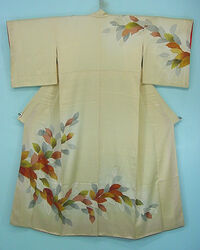
A fashionable Houmongi from the 1970s, with an autumn foliage pattern.
Houmongi are considered to be more formal than Tsukesage. The background can be any color (including black and white), and the design is dyed in such a way that it extends smoothly across the seams when the kimono is sewn together, creating an unbroken design.
It is traditionally considered a 'visiting kimono'. Its level of formality makes it suited to parties and receptions, going to tea, attending a graduation ceremony, theater or a concert, or a museum exhibit. It may be considered too formal for going out to lunch in some cases, and is considered too fancy for more mundane tasks such as shopping, traveling, or practice of traditional arts like ikebana and dance.
Please keep in mind that these notes on formality apply to wear in Japan, whereas wear in the west is more relaxed because of a number of factors, such as limited availability of kimono in the US, and a lack of knowledge in the general public. In the US, amongst American kimono enthusiasts, it's more reasonable to be 'pretty close' to correct than be spot-on.
Rarely, kamon may be applied to a Houmongi. One, three, or five may be applied, making it suited to more formal situations, but unsuitable for others like casual parties or going out to lunch. Even with five crests, a houmongi is not considered as formal as an Iro-Tomesode or Kuro-Tomesode.
Tsukesage[]
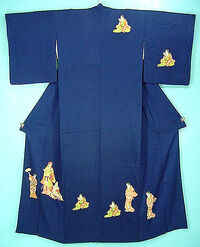
A Tsukesage from the 1970s displaying ladies painted in ukiyo-e style.
Tsukesage are visually quite similar to Houmongi, but rather than displaying flowing patterns, a Tsukesage's designs are dyed in such a way that they do not cross the seams. The only exception to this is that the pattern is allowed to cross the seam of the okumi (front overlap panel). Like Tsukesage, the background can be any color, including black and white.
While the level of formality of the Tsukesage is similar to the Houmongi, it is not considered as formal as its smooth-patterned sister. The Tsukesage may also rarely display kamon, but not more than three, meaning it cannot be worn for ceremonial occassions.
Further adding to the confusion, Tsukesage are sometimes designed as "Tsukesage-Komon" (see below), pairing the dyeing style of a Tsukesage with a less distinct all-over pattern.
Houmongi-Tsukesage[]
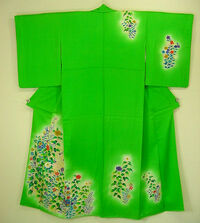
Notice the pattern that is unbroken on the left side, but broken on the right side.
These hybrids share characteristics of both Houmongi and Tsukesage, with smooth and broken designs. Most often, these hybrids have an unbroken design that sweeps around the hem, but separate Tsukesage-style patterns dyed on the shoulders and sleeves, though this is not a hard rule.
As formality is concerned, this is a relatively 'middle of the road' kimono that can be 'dressed up' or 'dressed down' depending on how it is accessorised, to bring it closer to either a Houmongi or a Tsukesage in formality.
Tsukesage-Komon[]
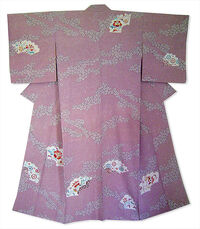
A hybrid design.
This unique hybrid combines the traditional dyeing pattern of Tsukesage with an underlying, all-over pattern of a Komon.